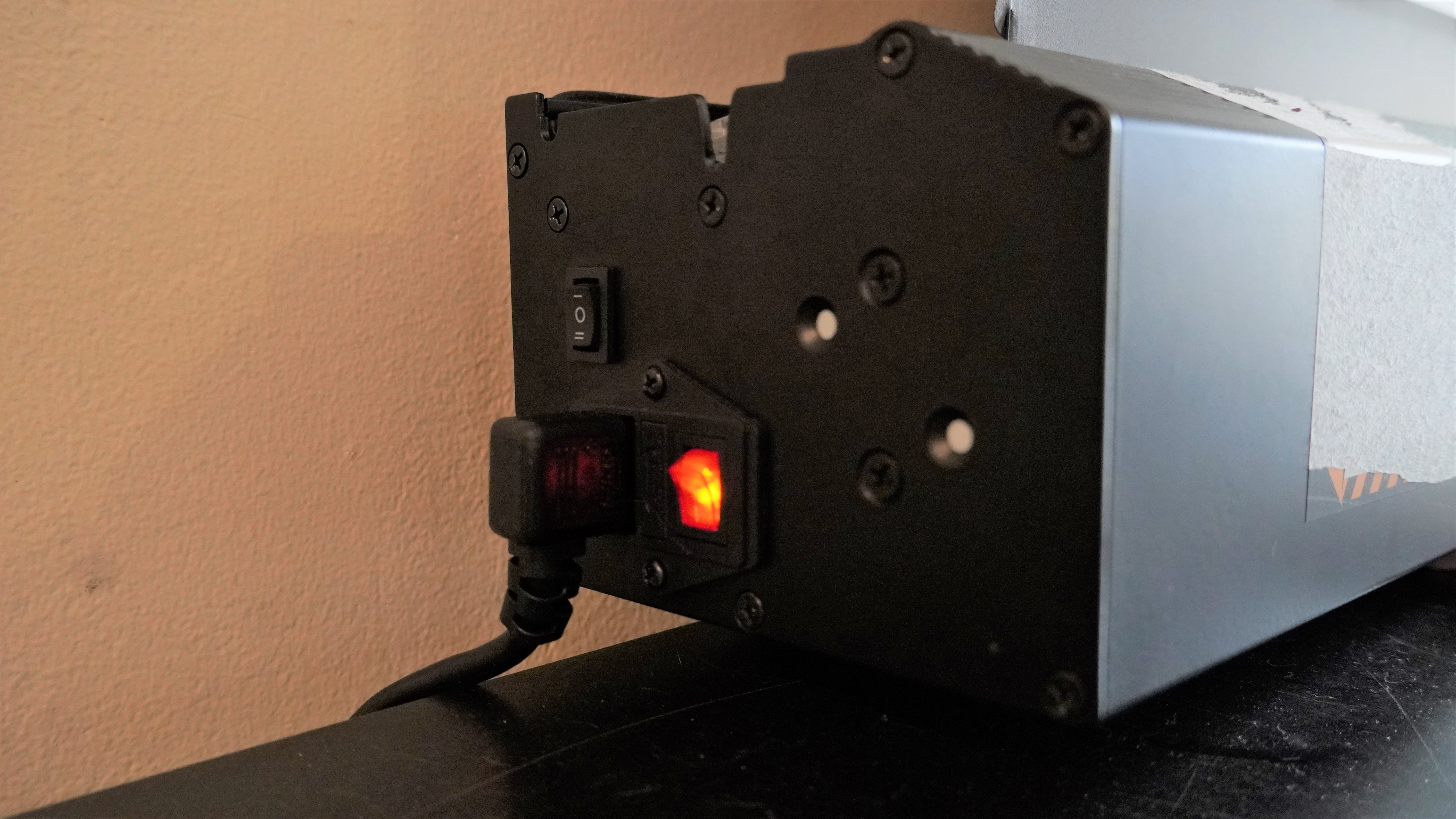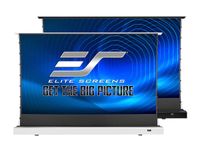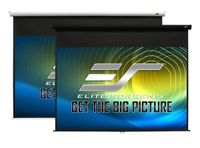TechRadar Verdict
Akia Screens’ Floor Motorized Tab-Tension CineWhite projector screen is versatile and tucks away nicely, though the convenience of a motorized display here comes at a major premium.
Pros
- +
Versatile
- +
Quick, convenient operation
- +
Quality projection surface
Cons
- -
Much of price is the mechanism
- -
No ambient light rejection
Why you can trust TechRadar
Even the best projectors can use a little support, and getting a screen is one way to max out your projector. Akia Screens’ floor motorized tab-tension CineWhite (AK-FMT) projector screen is a premium option that provides a flexible system for those looking to establish a quality home theater that’s not a permanent installation.
The $1,299 unit fits a 102-inch screen into a long, metal housing which extends and retracts the whole display in a few seconds using a fairly silent motor and scissor mechanism. It’s convenient to use, sturdy, and discreet. There are even some safety considerations with a pressure-sensitive strip that prevents pinched fingers.
A big portion of the budget is going into the motorized system, but it provides some convenient options for integration into your home theater, as you can link the opening and closing of the screen to the power cycle of your projector.
The portion of that budget that goes into what the screen is delivering is a solid one. It’s held taut with a tab system that provides an especially flat surface for a pristine picture. It provides a wide viewing angle, but doesn’t do much to cut down on ambient light. It’s also not doing much to filter out light from above like screens made specifically for ultra short throw projectors.
This screen won’t be for everyone, and you should be sure you know what to look for when choosing a projection screen, but it’s a great all-rounder that can work for long throw, short throw, and ultra short throw projectors. Its versatility could be a perk for some, but if you’re committed to a specific projector and setup, you could be better suited by a permanent and more purpose-built solution.

What you get when you open the AK-FMT projector screen is a huge black box, literally. The whole unit comes fitted in a low-key, black metal housing. It stretches just about six inches wider than the width of the screen itself, but it’s extra space that you’ll need to account for if you’re planning on a tight fit into your home. It’s also 57 pounds that you might want help moving around because of its unwieldy nature, if not because of the weight alone.
One immediately unfortunate bit of the design is that it sits on simple, rubber, rectangular feet. There are no built-in tools for ensuring the case is perfectly level, so if the floor or media center you’re putting the unit on isn’t already level, it could cause issues that will be tedious to sort out. Considering many projectors have adjustable feet, you’d think a device built with the projection industry in mind might have similar considerations.
Sign up for breaking news, reviews, opinion, top tech deals, and more.
Akia Screens did put some other thoughtful tools into the unit, though, especially as far as being able to incorporate it into a home theater setup. The system has a handful of means for controlling it, including a power switch on the side and a toggle for rolling up and extending the screen. It also comes with two remote controls: one infrared and one radio frequency. The unit supports a hardwired connection to your projector to link the control between them, and there’s also a wireless 12V trigger USB dongle that can send a signal to open and close the screen with a projector’s power cycle, though I only managed to get it working in one direction.
Both remotes work well, as does the switch on the side of the system. It’s worth noting that the screen emits a loud beep, like a cargo truck in reverse, for the first second after it’s powered on. The motor makes a bit of noise as well, but it’s a fairly low-volume whine.

The screen extends with a scissor mechanism in the back, so it’s worth being careful around. But aside from that bit, there’s little to worry about. Akia Screens built a pressure-sensitivity trip into the edges of the housing that will stop the motor, so it can avoid pinching fingers or anything caught between the housing and lid while the projector screen closes up. (That protective strip isn’t present on the sides of the housing, though.)
Extended, the projection screen stands up to 64.8 inches tall. The viewing area measures 91.3 x 50 inches, and there’s a bit of black material at the bottom of the screen. Though the screen material extends all the way to the sides, not all of it can be used for viewing, as the outer edges aren’t perfectly flat and can slightly warp the picture if projected there.
The whole screen is held taut with strings that run up either side and weave through small tabs of extra screen material. It’s also backed by a black material that keeps light from coming through the rear and washing out the image. The lightweight screen is a bit more susceptible to moving air though, and can wobble about from a breeze or strong fan running in the room.

The AK-FMT makes for a large, pretty picture. It’s not the most involved screen, though. A $1,000-plus screen might seem like it should come with some especially enhanced picture quality, but much of the cost is coming from the motorized system. A similar screen without the motorized housing costs less than half as much.
That’s not to say it’s a bad screen. It presents an exceedingly flat surface that ensures the projected image is virtually faultless. Compared to a wall, which may have lumps, cracks, and texture, the screen is much smoother and makes for a better projection surface. This is especially true for use with ultra-short-throw projectors, as the extreme projection angle makes wall imperfections appear more exaggerated than with standard projectors.
The matte surface has a 1.1 gain and isn’t serving to reject ambient light. But with a bright enough projector it makes for a solid backdrop that can appear impressive even if ambient light isn’t reduced. For instance, used with the new LG Cinebeam HU915QE, white highlights in images are powerful, while shadows look incredibly dark. Colors also get a great surface to pop off of. Viewed on Netflix, Cyberpunk Edgerunners’ dramatic color simply explodes off the surface. Much of a screen’s potential will depend on the projector it's paired with, and this one would make a solid partner for a high-end model like the Epson Pro Cinema LS12000.
A downside of this screen surface is that ultra short throw projectors like the Hisense PX1 Pro Ultra will see a good deal of their light reflected off at all angles. Plenty of it makes it to your eyes, but projection screens designed specifically for those models may be the better choice.

Akia Screens floor motorized tab-tension CineWhite projection screen review: Price & Release date
- $1,299 (US only)
- First available: March 2022
The Akia Screens Floor Motorized Tab-Tension CineWhite projector screen is sold only in the US and is available for $1,299. That price might strike some potential buyers as being somewhat high, but much of the cost here goes into the motorized lift mechanism and aluminum housing, which is sturdily constructed. You’ll pay more for similar models featuring a ceiling light rejecting screen specifically designed to maximize image quality with ultra short throw projectors. Another, considerably less expensive, option is to buy a ceiling or wall-mounted manual pull-down screen, though it will lack the Akia Screens' motorized magic and coolness factor.
Akia Screens floor motorized tab-tension CineWhite projection screen review: Specs
Screen material | Matt white |
Screen gain | 1.1 |
Aspect ratio | 16:9 |
Display size (diagonal) | 102 inches |
Viewing angle | 180 degrees |
Compatible projectors | Long throw, short throw, ultra short throw |
Mount type | Motorized, floor-rising |
Case width | 88.9 inches |
Should you buy the Akia Screens floor motorized tab-tension CineWhite projection screen?
Section | Notes | Score |
|---|---|---|
Features | Could use feet for levelling out the screen, but synching ability with projectors is great. | 4.5/5 |
Design | Sturdy build quality and smooth action from motorized screen lift. | 4.5/5 |
Picture quality | Good overall picture quality, though not optiimized for ultra short throw projectors. | 4/5 |
Value | Somewhat pricey, but less so than similar models. | 4/5 |
Buy it if...
You need a discreet screen
Though the AK-FMT can expand to provide a 102-inch projection area that would dwarf many TV screens, it automatically rolls back into a discreet package that doesn’t command too much attention when not in use.
You can’t go for a permanent setup
You can get a great screen for a lower price, but it can be harder to find a good deal if you can’t go for a permanent (or at least semi-permanent) installation. This provides a lot of the quality in a package you can pick up and move.
You’re planning an elaborate setup
Though you’ll need to accommodate the size of the AK-FMT’s housing, it provides some flexibility to fit it into an elaborate setup, especially with deciding how to deploy it and sync it up with a projector.
Don’y buy it if…
You don’t need a motorized setup
It’s nifty being able to raise and lower the projection screen with the flip of a switch, but it comes with a huge premium. If you don’t need the motor, you can save a ton of money with a manual screen that will look just as good.
You want the ultimate picture for an ultra short throw projector
The AK-FMT is solid, but UST projectors can benefit from a specifically designed screen built to better redirect the light beaming up at it outward toward viewers.
You’re dealing with a lot of ambient light
This screen looks stunning in a dark room, but it’s not going to cut down on ambient light if you’ve got a bright room with no blackout shades.
Akia Screens floor motorized tab-tension CineWhite projection screen: Also consider

Elite Screens] Kestrel Tab-Tension 2 CLR 3 Series
At $2,320 for a 100-inch 16:9 aspect ratio screen, this is a pricier option than the Akia Screens motorized model, but features a ceiling light rejecting screen specifically designed for use with ultra short projectors that maximizes light output. It’s also available with a white or a black case.

Elite Screens Manual Series (M100XWH)
This inexpensive ($249) 16:9 aspect ratio matte white screen is a manual pull-down model with a dual wall/ceiling mount case that comes in either black or white. While not as fancy as the Akia Screens motorized screen it's an affordable option for someone seeking to hide a projection screen when not in use.

Over the last several years, Mark has been tasked as a writer, an editor, and a manager, interacting with published content from all angles. He is intimately familiar with the editorial process from the inception of an article idea, through the iterative process, past publishing, and down the road into performance analysis.
